[BR] LTL - Zuum Store + Carrier Connections
- Overview
- B1 View full list of LTL carriers
- B2 Request to add connection with listed carrier
- B2.0 As a user, I can see a full list of LTL carriers that I can connect to displayed in a table that I can search, sort, and filter.
- B2.1 As a user, I can fill in my information for each LTL carrier that I want to request connection with.
- B2.2 As a user, I must consent to Zuum making a connection on my behalf and must acknowledge that there will be charges for creating LTL carrier connections.
- B2.3 As a user, I must consent to Zuum making a connection on my behalf and must acknowledge that there will be charges for creating LTL carrier connections.
- B2.4 As a user, I need to know if my request was submitted successfully and whether there will be any follow-up.
- B2.5 As a user, I can see that my request has been submitted and that a carrier connection is pending.
- B3 Cancel pending connection request with listed carrier
- B3.0 As a user, I can cancel a pending connection request with a listed carrier.
- B3.1 As a user, I can cancel a pending connection request with a listed carrier.
- B3.2 As a user, I receive a message confirming that my request has been successfully canceled.
- B3.3 As a user, I can see the status of my request is no longer ‘Pending’.
- B4 Request to add connection with unlisted carrier
- B4.0 As a user, I can request to connect with an unlisted carrier.
- B4.1 As a user, I can request to connect with an unlisted carrier by filling out some information.
- B4.2 As a user, I can request to connect with an unlisted carrier by filling out some information.
- B4.3 As a user, I can see that my request was successfully submitted.
- B5 Request to remove carrier connection
- C Statuses and Buttons within the Data Table of LTL Carriers
Document status | COMPLETE |
|---|---|
Last Updated |
|
Document owner | |
Designer | |
Dev Team |
|
Design Link | |
Design File | |
Related Documents | |
Version | V1: |
Overview
Brokers can connect with LTL carriers in order to return LTL carrier rates when building LTL shipments. In order to do so, they must first be connected to an LTL carrier.
Note: These specifications also apply to shippers. The Confluence document for shippers can be found HERE.
To connect with an LTL Carrier, a user must visit their Zuum Add-ons Store and click on the LTL tile to be taken to the LTL page.
Note: LTL Icon Visibility within the Zuum Store is Toggled in the Super Admin. By default, LTL is visible for everyone and also activated. Please see the Confluence document here.
About Banyan
Zuum will return LTL carrier rates by using Banyan. Banyan facilitates the connection between a Zuum customer and their selected LTL carrier. Banyan sets up connections to transact shipments with current partners of Zuum (and its customers) based on existing agreements between Zuum and an LTL carrier or a customer and their LTL carrier.
Banyan will set up Zuum as a “parent” account within Banyan’s web interface. Any Zuum shipper or broker customer that wishes to have access to LTL carrier rates will be set up as a “child” of Zuum.
Four Types of Requests a User Can Make
Add Connection with a Listed Carrier: this means the customer wants to connect with a specific LTL carrier so that they can be returned this LTL carrier’s rates when searching within Zuum. Once connection has been made by Banyan, the user will see their LTL carrier’s rates being returned when searching within the Zuum platform. See Flow B2.
Cancel a Pending Connection Request: if a user clicks
Add Connectionbut then changes their mind or does not wish for the connection to be made, they could request to cancel their pending connection request. See Flow B3.Request a Connection with an Unlisted Carrier: if a user does not see a carrier they use in the standard/base list of carriers provided by Banyan, they can request to be connected to an unlisted carrier and have this carrier show up in their LTL carriers list. If Banyan can make the connection, this carrier would be added to the user’s LTL carrier list. Once connection has been made by Banyan, the user will see their LTL carrier’s rates being returned when searching within the Zuum platform. See Flow B4.
Remove Connection with a Carrier: after being connected with an LTL carrier via Banyan, a user may change their mind or may not want to see results returned for this specific LTL carrier. Keep in mind that users are charged based on the number of LTL carrier connections that they have (the more carriers, the more they are charged each month). See Flow B5.
Note: Any request submitted by a customer opens up a ticket within Zendesk.
How Requests are Handled
When a customer requests to connect to an LTL carrier through Zuum, they must submit their Username/Login ID and password. An API key is optional. This information must be encrypted so that it can be sent to Banyan to be decrypted.
Whenever a customer submits a request. a ticket is opened up within Zendesk, in a queue titled “LTL Queue”. The customer is notified by an email from Zendesk that their request ticket has been opened.
A Zuum Tech Support person, or the person who manages and works out of the LTL Queue must take the request ticket and pass this on to Banyan. Banyan will respond to the ticket (either through replying in the ticket email) or by notifying Zuum Tech Support. Zuum Tech Support must update the ticket or close the ticket.
Closing a ticket sends an email to the customer letting them know their ticket has been closed.
The general process for LTL related requests from opening to closing the request ticket is illustrated in the diagram below.
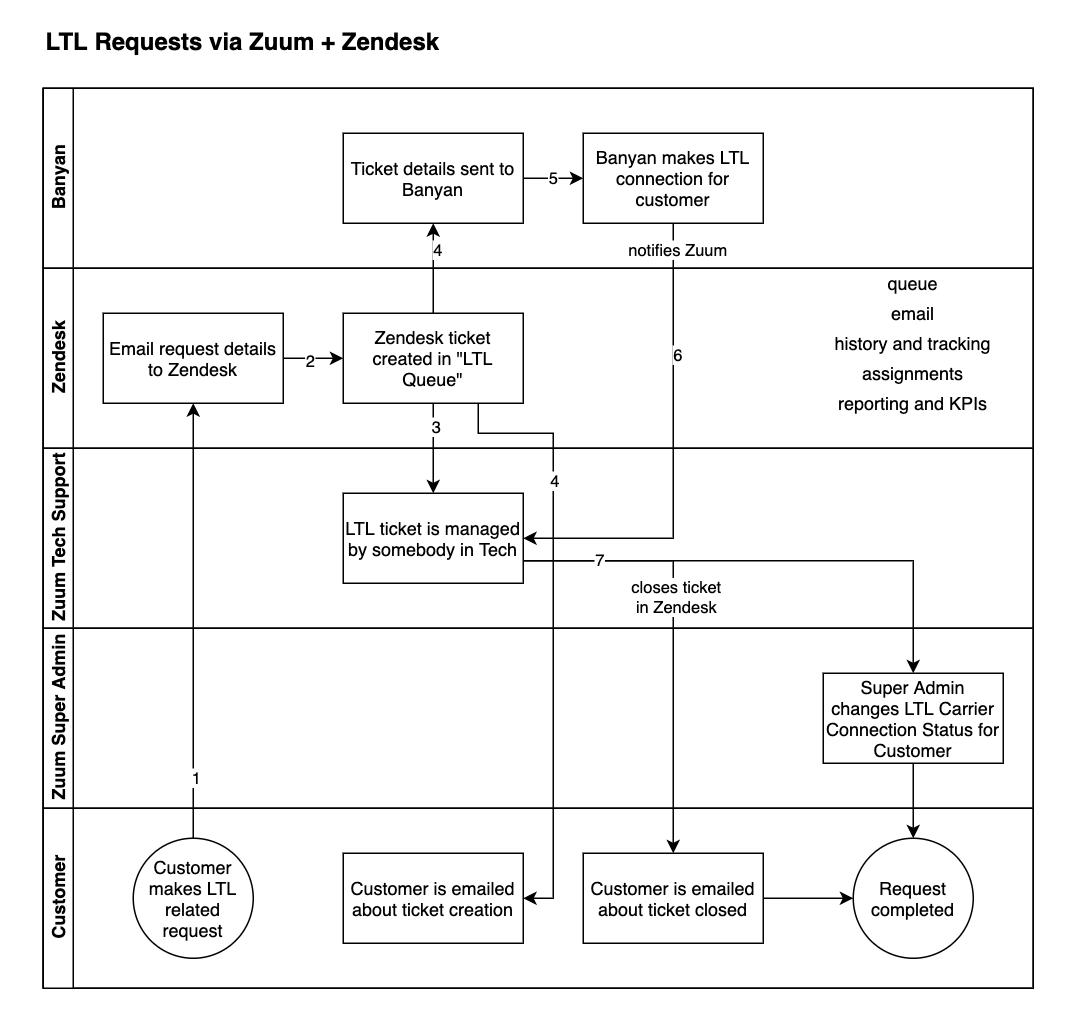
Flows B1 through B5 below show the different interactions a user can make in connecting with LTL carriers.
B1 View full list of LTL carriers
User Story: As a user, I want to be able to see which LTL carriers are available for me to connect with so that I can request to connect with them to see my contract rates displayed within Zuum.
B1.0 As a user, I can see the LTL tile in my Zuum Add-ons Store.
Design: Figma
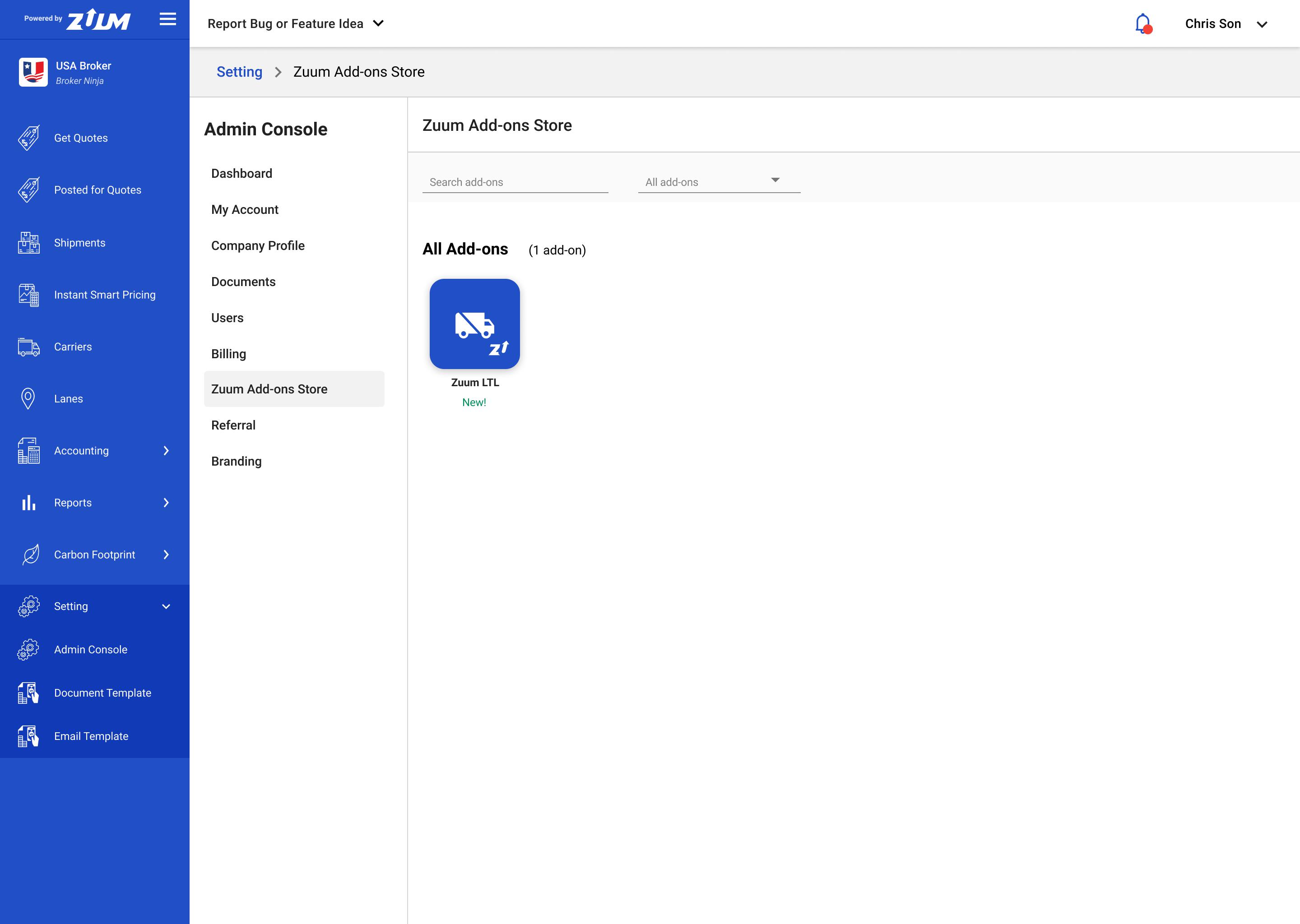
Clicking on the tile takes the user to Screen B1.1.
B1.1 As a user, I can see a full list of LTL carriers that I can connect to.
Design: Figma

NOTE: Tiers and Pricing to be determined in conjunction with Marketing.
NOTE: The table displays LTL carriers that Zuum has contracts with. If an LTL carrier isn’t listed, the customer must click on Request a Connection to request an LTL carrier.
This summary box is at the top of the page in order to let the user understand their carrier rate connections at a glance.
The total number of carrier rate connections displays here. The user gets charged for the number of carriers they are connected to. The monthly charges will show up in the Super Admin > Billing > Invoices as well as the Bill Collection page. The user will also see the monthly charge on their Billing page.
This is where the payment tier is displayed, for example, Tier 1 would be for up to 5 carrier connections, Tier 2 would be for up to 10 carrier connections, etc. See Screen B5.0 of this document to see how this would look once the user is connected to at least 1 LTL carrier. (pricing tiers to be determined with Marketing)
Clicking this would open a modal showing the pricing structure of different tiers (modal to be designed after pricing determined with Marketing).
Users can search for a specific LTL carrier by name. After typing in their search terms, the table below would update with the search results.
This filter allows users to filter by Connection Status. Users can filter to see carriers dependent on Connection Status:
“All Carriers” - all the LTL carriers that Banyan provides connection to, regardless of whether the user is connected to these carriers or not.
“Connected” - a user has requested connection to this LTL carrier, Zuum has passed the user’s information to Banyan, Banyan has facilitated the connection, and so the user is connected to that carrier.
“Pending” - a user has requested connection to this LTL carrier, Zuum may or may not have passed the user’s information to Banyan, Banyan has NOT facilitated the connection yet, and so the user is not yet connected to that carrier..
“Not Connected” - a user has not requested connection to this LTL carrier and is therefore not connected with this LTL carrier.
If a user does not see a carrier listed, they can request a connection with a carrier. Clicking on the button
Request a Connectionstarts the flow outlined in Section B4 of this document. Completing this flow would open up a ticket in the Zendesk LTL Queue. A Zuum tech support person who handles the LTL Queue in Zendesk would take the information the user submits via the modal Screen 4.1, including the Requested Carrier name, and pass this information onto Banyan. Banyan would have to make a determination to see if it is possible to connect the customer to their Requested carrier. If the connection is possible, Banyan would have to set up the carrier connection.Users can sort the table by LTL Carrier name. In the example above, the carriers are displayed in alphabetical order. The user can sort by A to Z or from Z to A. The only other sorting available is outlined in number 9 below.
Users can also sort the table by Connection Status. See annotation 6 above for the different connection statuses. Section C also contains the different statuses and badges.
The buttons at the end of the row change depending on whether information has been filled out and depending on what action has been taken by the user. Also see Section C of this document.
Add Connection(disabled) - inactive because user has not filled out all required fieldsAdd Connection(enabled) - active once user fills out all required fieldsRemove Connection- active if a user is connected to a carrierCancel Request- active if a user has submitted a request to connect with a carrier but the connection hasn’t been made yet
Use pagination footer and logic from existing pages to organize the table. There is a possibility that we will have up to 200 LTL carriers listed.
B2 Request to add connection with listed carrier
User Story: As a user, I want to request connection with LTL carriers with whom I have contract rates, so that I can get these rates displayed within Zuum when building LTL shipments.
B2.0 As a user, I can see a full list of LTL carriers that I can connect to displayed in a table that I can search, sort, and filter.
Design: Figma
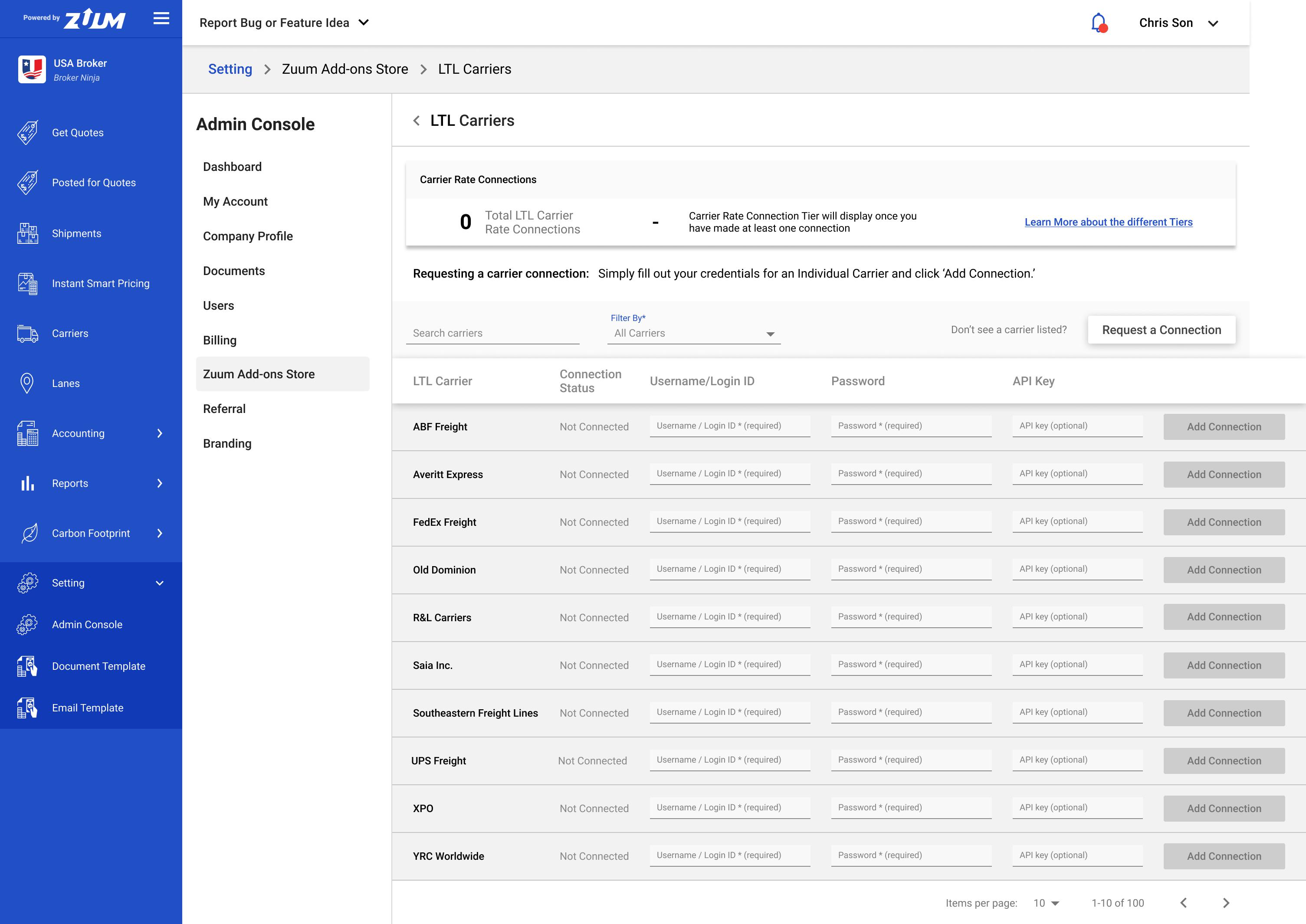
This screen is identical to Screen B1.0.
The user starts off in their LTL Carriers page then clicks into the row for the carrier that they want to connect to. The user must enter their Username/Login ID and Password. An API Key is optional. Hovering over and clicking into a row will resemble Screen B2.1.
B2.1 As a user, I can fill in my information for each LTL carrier that I want to request connection with.
Design: Figma
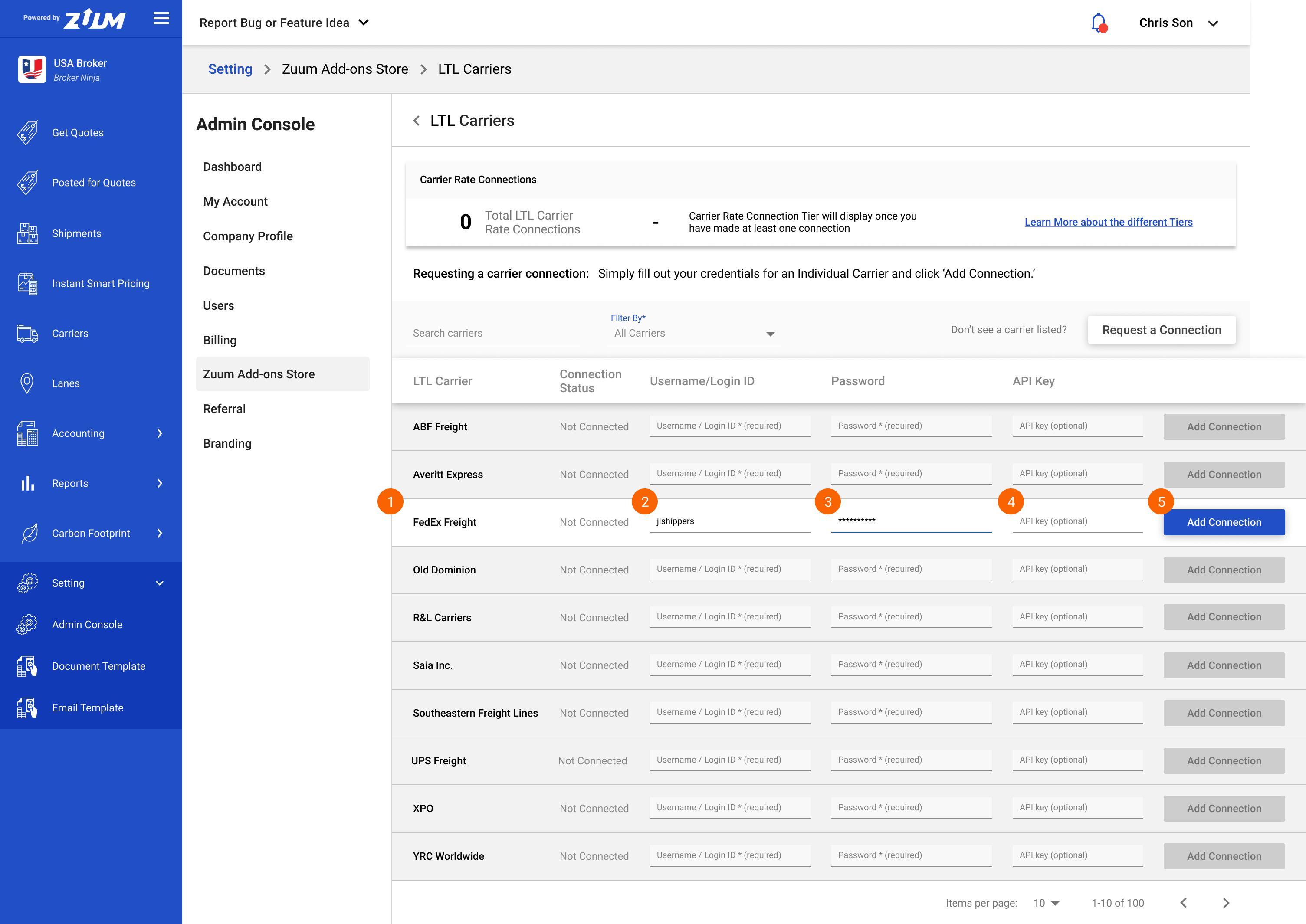
As the user runs their cursor over the table, the row they are currently on is highlighted (See Prod Broker Admin for an example of this interaction).
Username / Login ID is required. If this is not filled in along with Password, the
Add Connectionbutton at the end of the row will not be enabled.Password is also required. If this is not filled in along with Username / Login ID, the ‘Add Connection’ button at the end of the row will not be enabled.
API Key is optional.
Add Connection- This button becomes activated once the required fields (Username/Login ID and Password) are filled in. Clicking this button opens up an acknowledgement modal Screen B2.2.
B2.2 As a user, I must consent to Zuum making a connection on my behalf and must acknowledge that there will be charges for creating LTL carrier connections.
Design: Figma
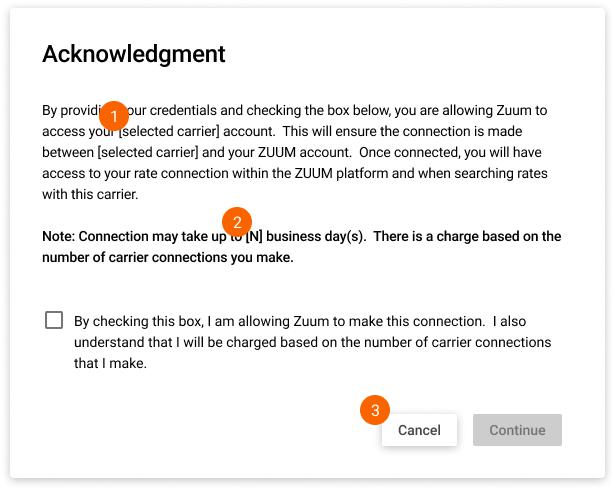
Replace [selected carrier] with name of LTL carrier (based on the row which the user just filled out)
Number of days for the process: 5. “Connection may take up to 5 business days.”
Clicking
Cancelcloses the modal.
Once a user clicks the checkbox, the modal changes to Screen B2.3 where the Continue button is enabled.
B2.3 As a user, I must consent to Zuum making a connection on my behalf and must acknowledge that there will be charges for creating LTL carrier connections.
Design: Figma
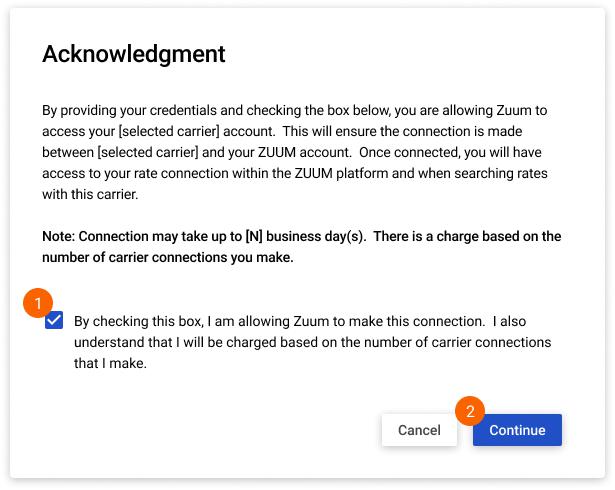
Clicking the checkbox activates the
Continuebutton (see annotation 2)This button is becomes enabled/activated once the user checks the box (see annotation 1). When the user clicks
Continue:a ticket is automatically created in the Zendesk “LTL Queue” via API. This ticket is tied to the user’s email associated with their Zuum account. API needs to be set up to take information submitted by user and to turn it into a ticket within Zendesk.
sends the user an email from Zendesk that a ticket has been opened for them. This email does not contain the user’s Username/Login ID, Password, or API Key.
A Zuum (tech) support person must forward this ticket to Banyan for Banyan to facilitate the connection. This ticket must include the user’s submitted information: Username/Login ID, Password, API Key)
the Connection Status in the table changes to ‘Pending.’ See Screen B2.5 and Section C.
B2.4 As a user, I need to know if my request was submitted successfully and whether there will be any follow-up.
Design: Figma
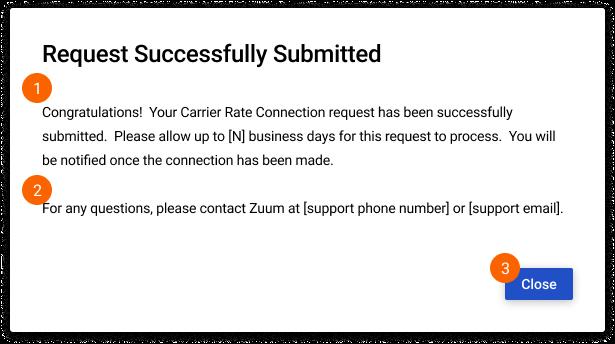
Number of days for the process: 5 days. “Please allow up to 5 business days for this request to process.” The user will be notified about the status of this connection request through the Zendesk ticket automatically generating an email when the ticket is closed.
Zuum support phone number: 1-800-410-1563. Zuum support email: support@zuumapp.com.
Clicking
Closecloses the modal and takes the user to Screen B2.5.
B2.5 As a user, I can see that my request has been submitted and that a carrier connection is pending.
Design: Figma
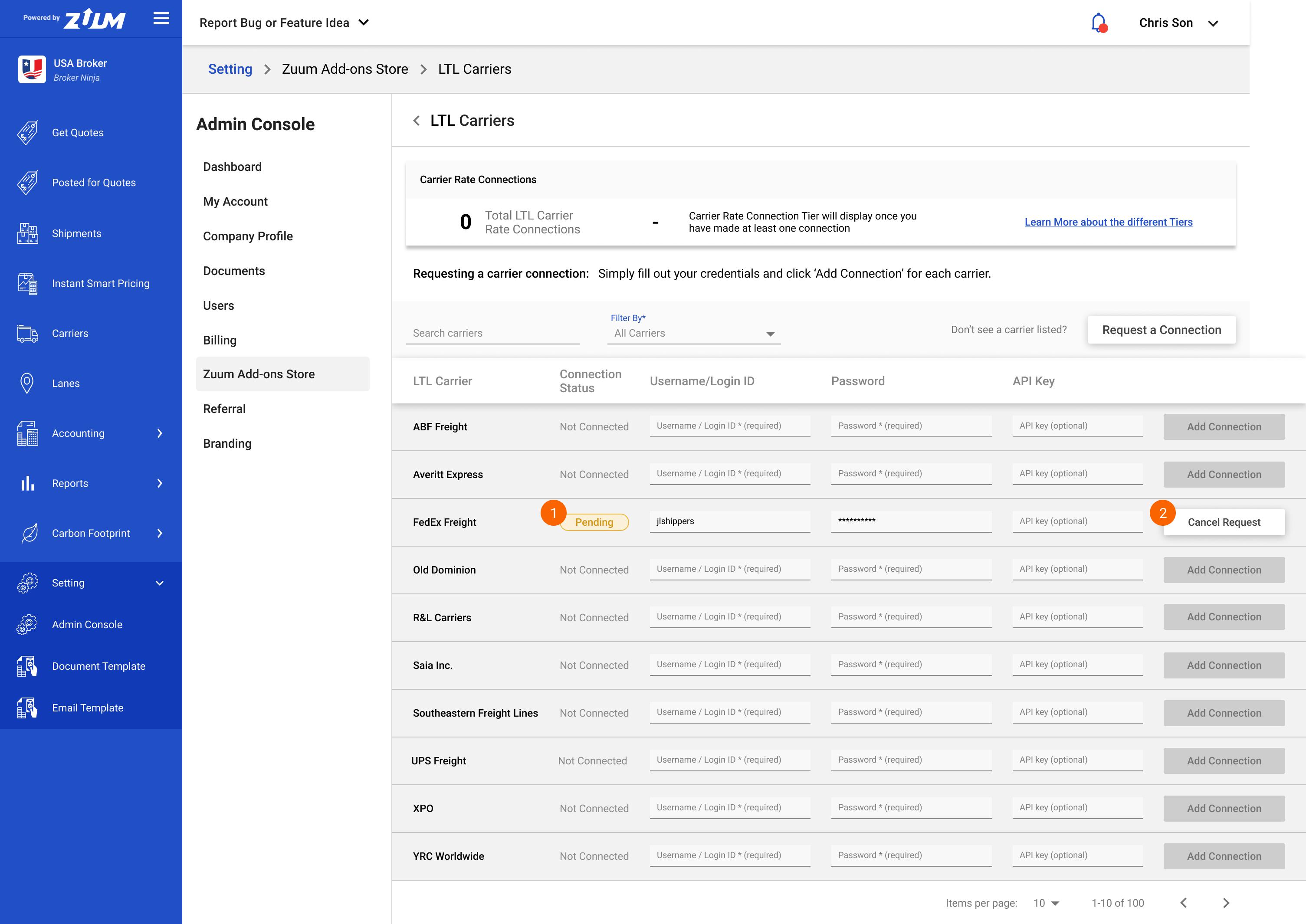
The Connection Status now shows 'Pending' because Zuum needs to handle the request and Banyan needs to make the connection. Badges can be found in Section C of this document.
The button now shows
Cancel Request. If the user wants to cancel their request, they can click this button and it will take them through Flow B3.
B3 Cancel pending connection request with listed carrier
User Story: As a user, I may need to cancel a pending connection request with a listed carrier (for example, if I change my mind).
B3.0 As a user, I can cancel a pending connection request with a listed carrier.
Design: Figma
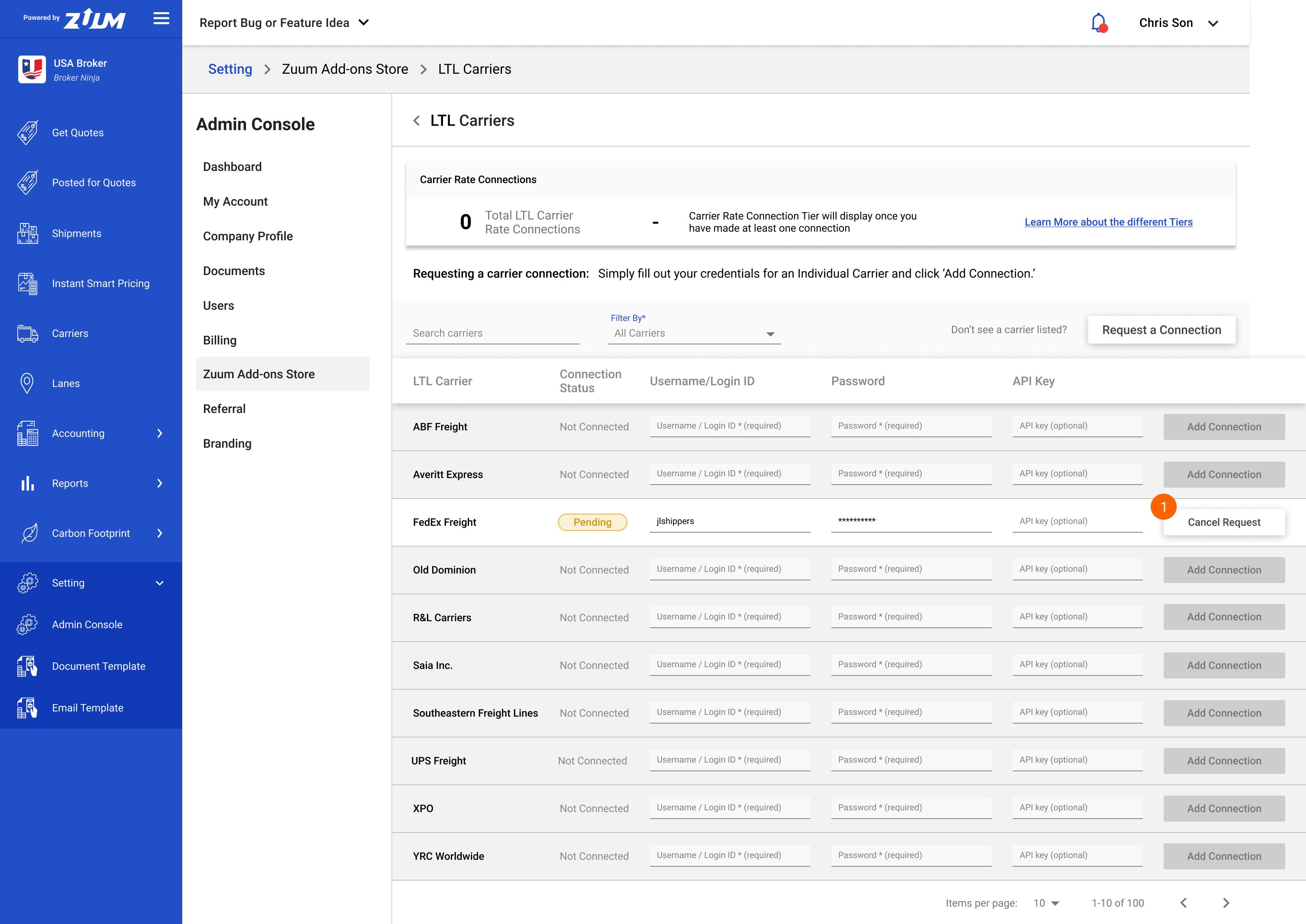
There may be a use case where a customer may want to cancel their request. Perhaps they made the request by accident - they may have selected the wrong carrier, for instance. Or, the customer may have changed their mind. They may only be limited to connect to a certain number of LTL carriers (since they are charged based on the number of LTL carrier connections they make) and they may not want to go over their limit.
Clicking
Cancel Requestopens up modal Screen B3.1.
B3.1 As a user, I can cancel a pending connection request with a listed carrier.
Design: Figma
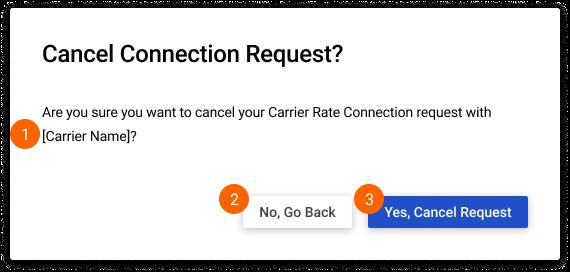
Replace [Carrier Name] with name of LTL carrier (based on the row in which the user just clicked)
Clicking
No, Go Backcloses the modal.Clicking
Yes, Cancel Request:a ticket is automatically created in the Zendesk “LTL Queue” via API. This ticket is tied to the user’s email associated with their Zuum account. API needs to be set up to take information submitted by user and to turn it into a ticket within Zendesk.
sends the user an email from Zendesk that a ticket has been opened for them.
A Zuum (tech) support person must forward this ticket to Banyan for Banyan in case they have already started the connection process.
takes the user to Screen B3.2.
The user’s previous connection request ticket for this specific carrier needs to be found and properly canceled/closed/archived within Zendesk. The reason why we need to have a cancelation of pending connection request flow through Zendesk is to have a record of the transaction.
B3.2 As a user, I receive a message confirming that my request has been successfully canceled.
Design: Figma
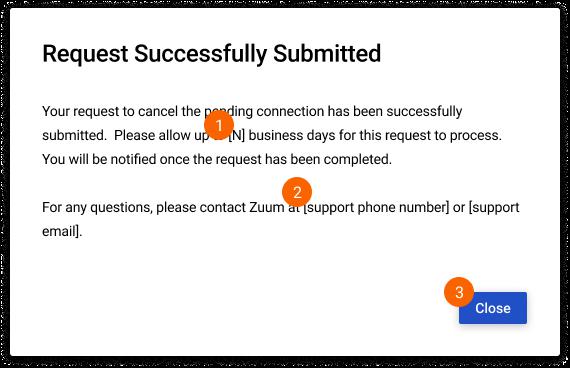
Number of days for the process: 5 days. “Please allow up to 5 business days for this request to process.” The user will be notified about the status of canceling a pending connection request through the Zendesk ticket automatically generating an email when the ticket is closed.
Zuum support phone number: 1-800-410-1563. Zuum support email: support@zuumapp.com.
Clicking
Closecloses the modal and takes the user to Screen B3.3.
B3.3 As a user, I can see the status of my request is no longer ‘Pending’.
Design: Figma
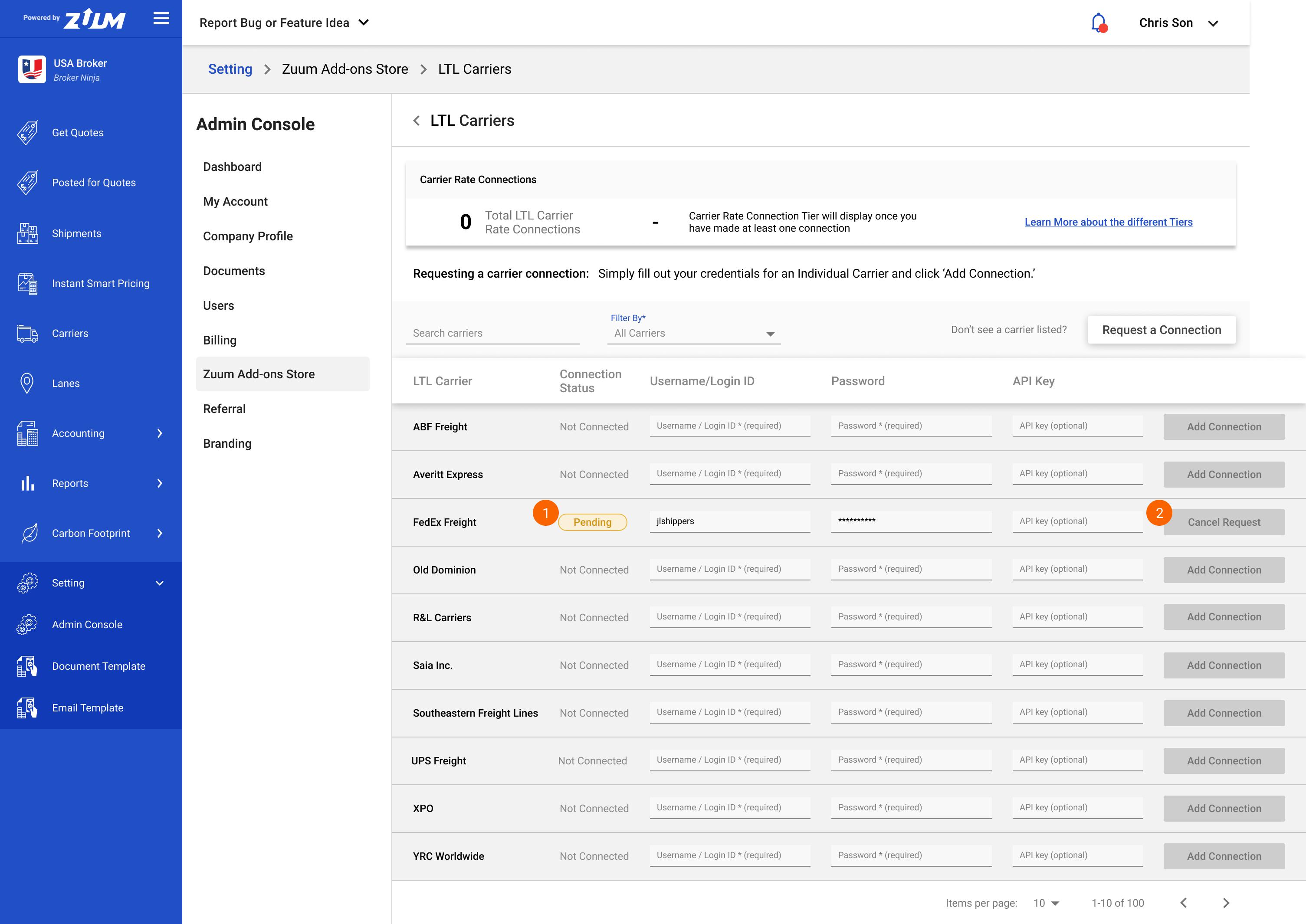
The Connection Status is still ‘Pending’ because there still needs to be action taken on Zuum and Banyan’s side. See Section C for all badges and buttons.
The button at the ned of the row still says “Cancel Request' but it is deactivated because the user cannot submit a duplicate request. See Section C for all badges and buttons.
B4 Request to add connection with unlisted carrier
User Story: As a user, I may want to connect with a carrier that I don’t see listed so that I can get my contract rates with them.
B4.0 As a user, I can request to connect with an unlisted carrier.
Design: Figma
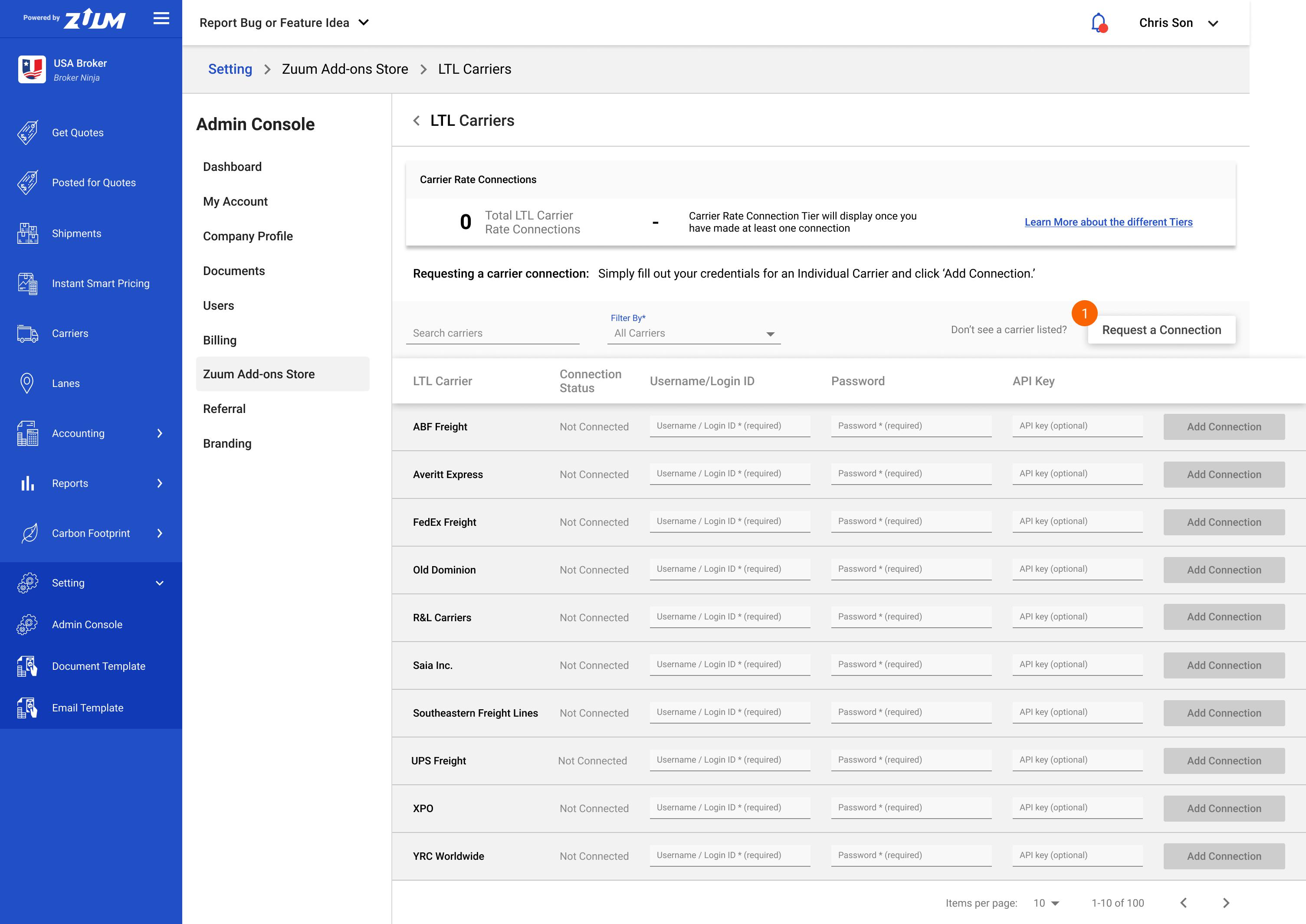
If a user doesn’t see a carrier that they would like to connect to, they can make a request. Clicking on
Request a Connectionopens up modal Screen B4.1. Zuum would take the information the user submits via the modal, including the Requested Carrier name, and pass this information onto Banyan. Banyan would have to make a determination to see if it is possible to connect the customer to their Requested carrier.
B4.1 As a user, I can request to connect with an unlisted carrier by filling out some information.
Design: Figma
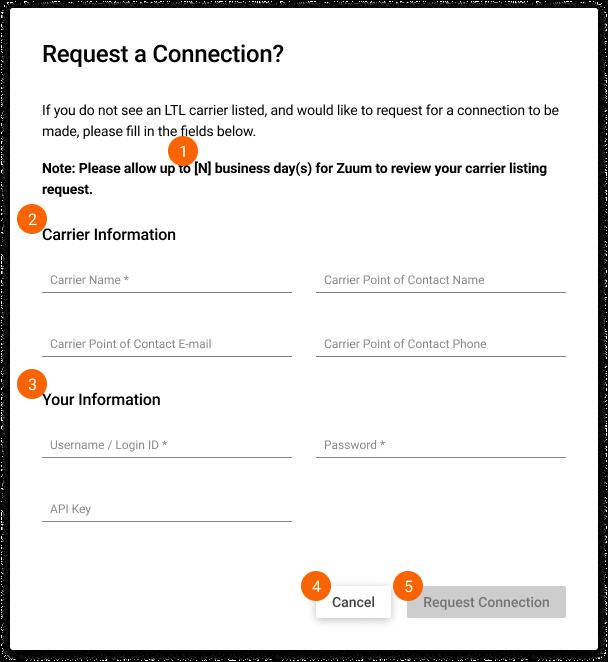
Number of days for the process: 5 days. “Please allow up to 5 business days for Zuum to review your carrier listing request.”
Carrier Information: Carrier Name is required. Other fields are optional.
Your Information: Username / Login ID and Password are required. API Key is optional.
Clicking
Cancelcloses the modal.Request Connectionis disabled until user fills out all required fields.
B4.2 As a user, I can request to connect with an unlisted carrier by filling out some information.
Design: Figma
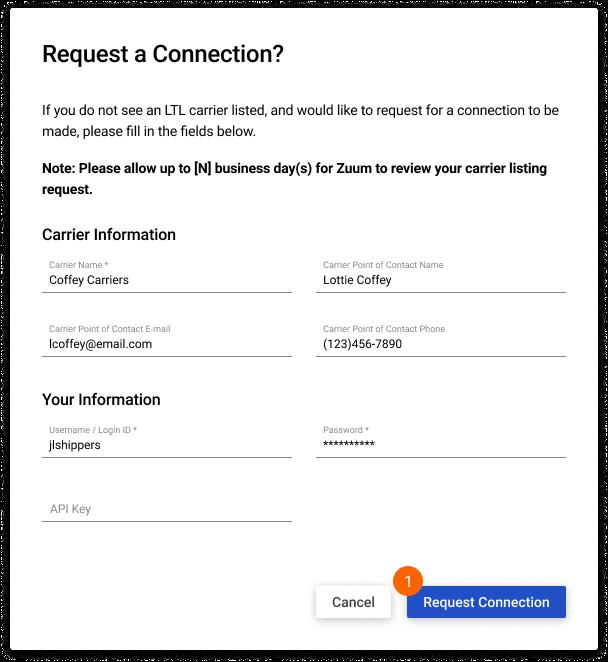
This button is active now that the user has filled out all required fields. When the user clicks 'Request Connection:
a ticket is automatically created in the Zendesk “LTL Queue” via API. This ticket is tied to the user’s email associated with their Zuum account. API needs to be set up to take information submitted by user and to turn it into a ticket within Zendesk.
sends the user an email from Zendesk that a ticket has been opened for them. This email does not contain the user’s Username/Login ID, Password, or API Key.
A Zuum (tech) support person must forward this ticket to Banyan for Banyan to see if they can facilitate the connection. This ticket must include the user’s submitted information: Carrier Name, Username/Login ID, and Password.
changes the modal to Screen B4.3.
B4.3 As a user, I can see that my request was successfully submitted.
Design: Figma
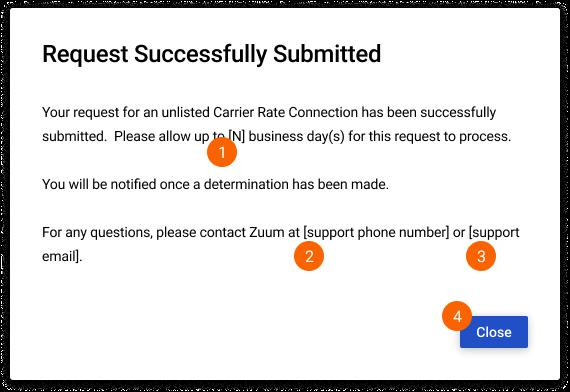
Number of days for the process: 5 days. “Please allow up to 5 business days for this request to process.”
Zuum support phone number: 1-800-410-1563
Zuum support email: support@zuumapp.com.
Clicking
Closecloses the modal.
B5 Request to remove carrier connection
User Story: As a user, I may want to be able to remove a carrier connection (for example, I might want to remove a carrier whom I don’t want to use any more, or I don’t want to go over a certain number of carriers in order to stay within a certain payment tier).
B5.0 As a user, I can remove connection with an LTL carrier.
Design: Figma
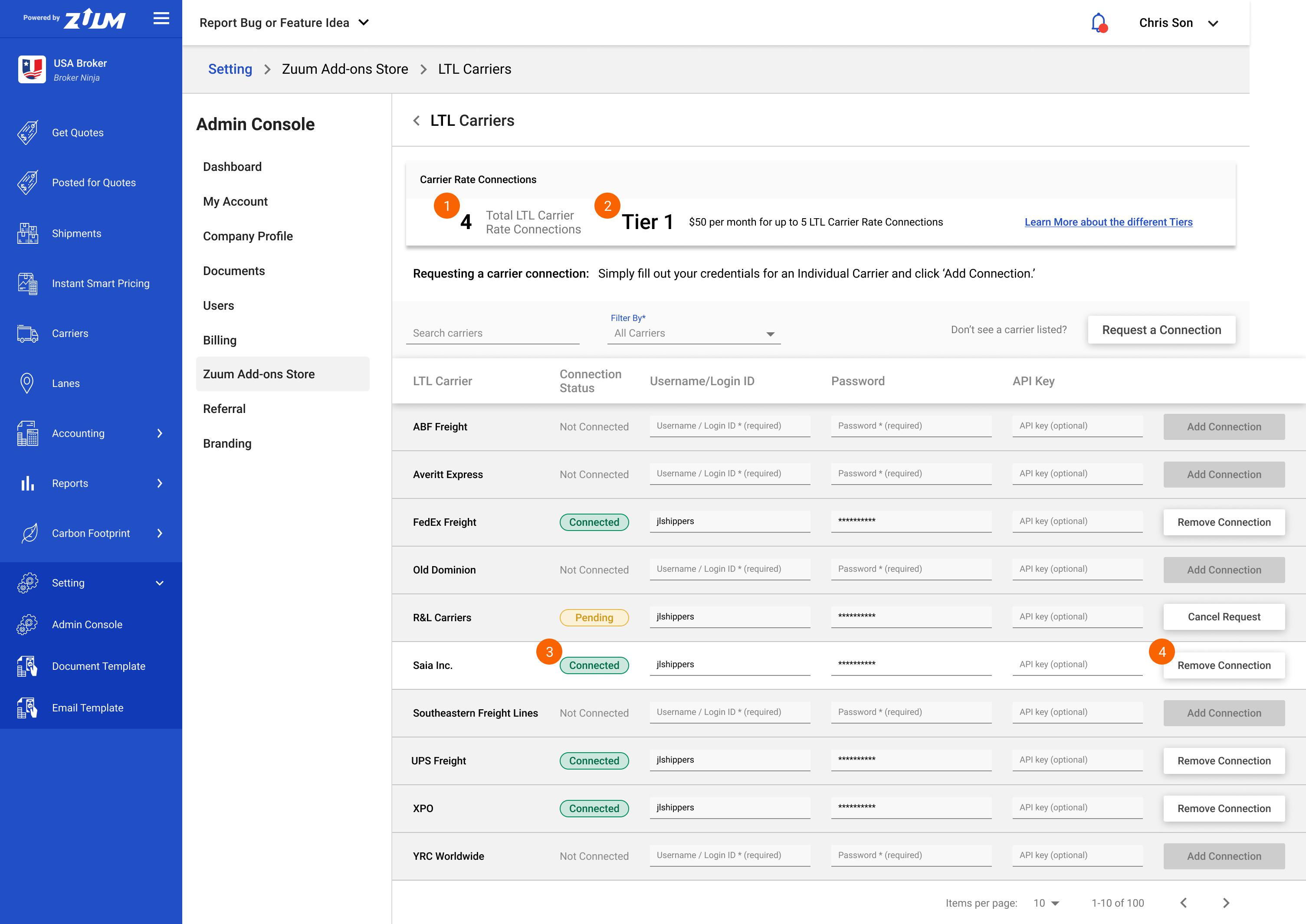
The total number of LTL carrier rate connections is shown here. This should match the number of carriers that the user is connected to in Banyan’s system.
The Tier number is displayed here. Next to the Tier number is a description of the Tier, for example “$50 per month for up to 5 LTL Carrier Rate Connections.” Tiers and Pricing Structure to be determined by Marketing.
This green ‘Connected’ badge displays once a carrier connection has been made, that is, Zuum has passed the customer’s information onto Banyan, the customer is set up within Banyan’s system, and is now getting returned their LTL carrier rates within Zuum when searching for prices.
Because the user is now connected to this LTL Carrier, they can no longer add a connection with this same carrier. Therefore, they can only request to disconnect from / remove the connection with the carrier. The button now says
Remove Connection. Clicking this button opens up modal Screen B5.1.
NOTE: Tiers and Pricing to be determined in conjunction with Marketing.
B5.1 As a user, I can remove connection with an LTL carrier.
Design: Figma
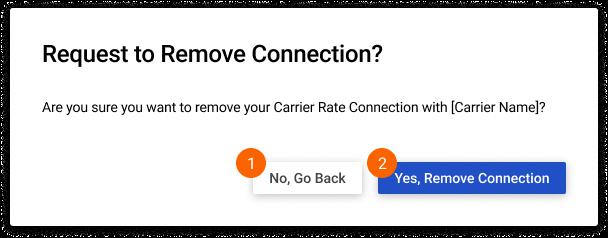
Clicking
No, Go Backcloses the modal.Clicking
Yes, Remove Connection:automatically creates a ticket in the Zendesk “LTL Queue” via API. This ticket is tied to the user’s email associated with their Zuum account. API needs to be set up to take information submitted by user and to turn it into a ticket within Zendesk.
sends the user an email from Zendesk that a ticket has been opened for them. This email does not contain the user’s Username/Login ID, Password, or API Key.
A Zuum (tech) support person must forward this ticket to Banyan for Banyan to remove the connection.
takes the user to Screen 5.2.
B5.2 As a user, I receive confirmation that my request was successfully submitted.
Design: Figma
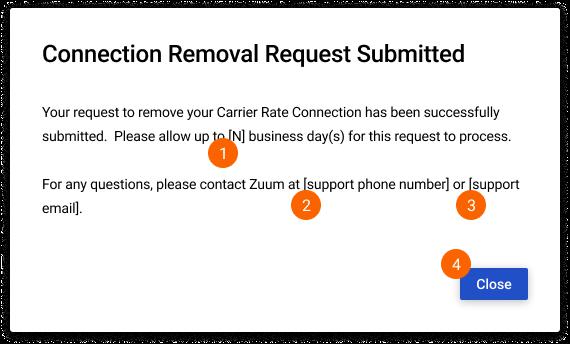
Number of days for the process: 5 days. “Please allow up to 5 business days for this request to process.”
Zuum support phone number: 1-800-410-1563
Zuum support email: support@zuumapp.com.
Clicking
Closecloses the modal.
B5.3 As a user, I can see the status of my connection requests.
Design: Figma
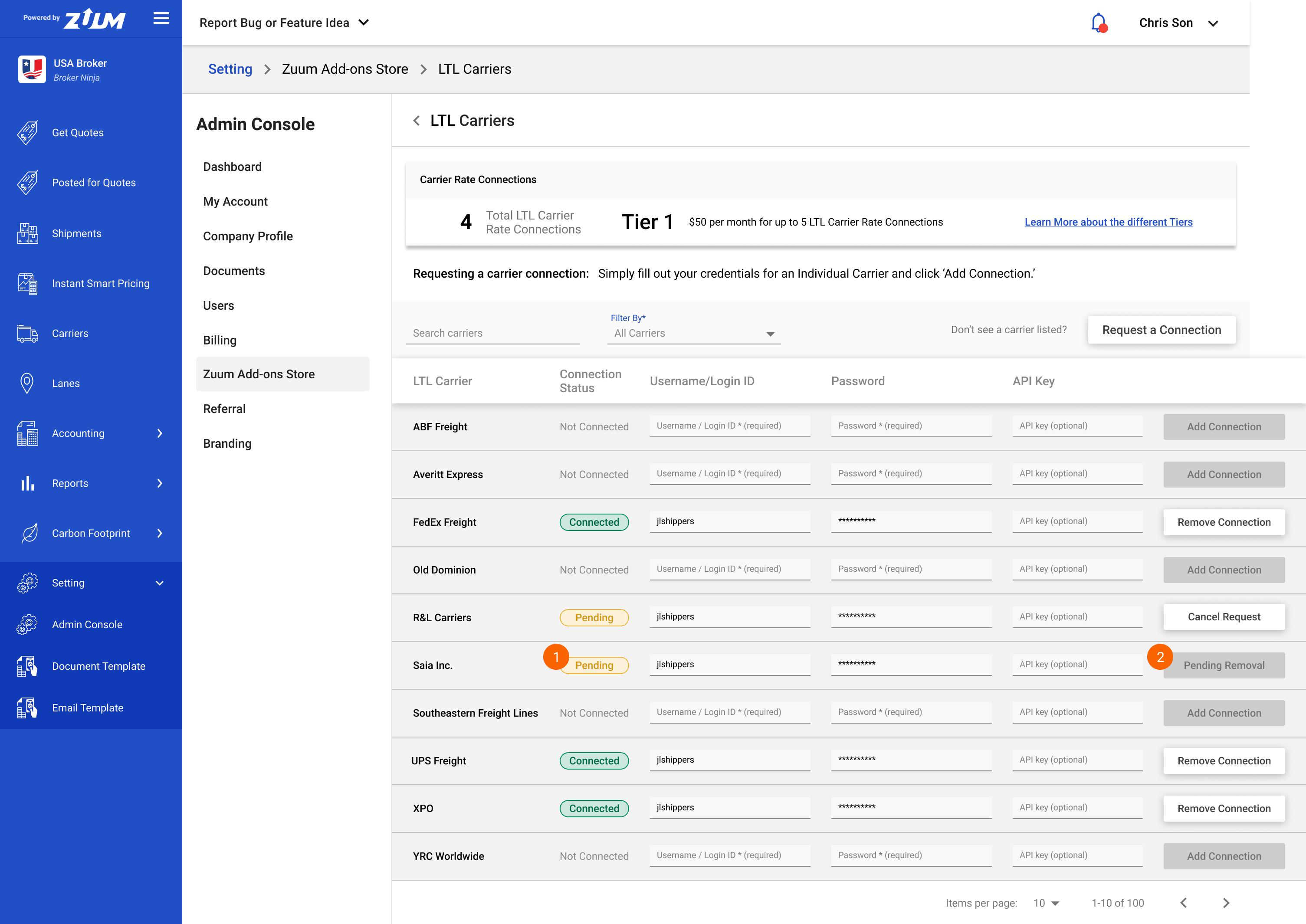
The status changes to “Pending” when a user submits a request to remove a connection. This status will revert back to “Not Connected” once Banyan completes the connection removal and Zuum.
The button saying
Pending Removalis disabled. This button will revert back toAdd Connectiononce Zuum and Banyan complete the connection removal.
C Statuses and Buttons within the Data Table of LTL Carriers
Design: Figma
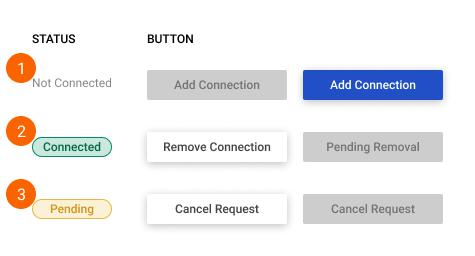
If a user is ‘Not Connected' to an LTL Carrier, the only button they will see in the row for that carrier is
Add Connection. The button is inactive/disabled until they fill out all required fields, then it will be enabled.“Connected” status occurs when a user has been connected to a carrier via Zuum/Banyan. This status has to be manually updated by the Zuum Super Admin. See Flow A2 in [SA] Less Than Truckload (LTL). At any time, a user can click on
Remove Connectionwhich will send a request to remove the carrier connection (Flow B5). The button would change to ‘Pending Removal’ (disabled), but the user is still technically connected to the carrier.“Pending” status occurs when a user:
has requested to connect with listed carrier (Flow B2).
has requested to connect with a listed carrier (Flow B2) but changes their mind and wishes to cancel a pending connection request (Flow B3). The user would see a
Cancel Request(enabled) button in this case. After clicking onCancel Requestto request canceling their pending connection, the button would still sayCancel Requestbut be disabled).
